[Synergistic Solar, TRS-80]
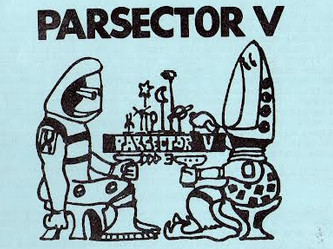
Admiral, we have a decisive advantage and now control 9 parsectors !
Perfect ! Where are they ?
No one knows, but surely we will find them eventually.

Our mothership has just arrived in a new cluster of parsectors of size 4×4, and we are trying to rightfully claim them for our civilization. Unfortunately, our sensors are tracking a hostile mothership, and we expect it to try to snatch them for their kultur. The campaign for the control of this cluster has started.
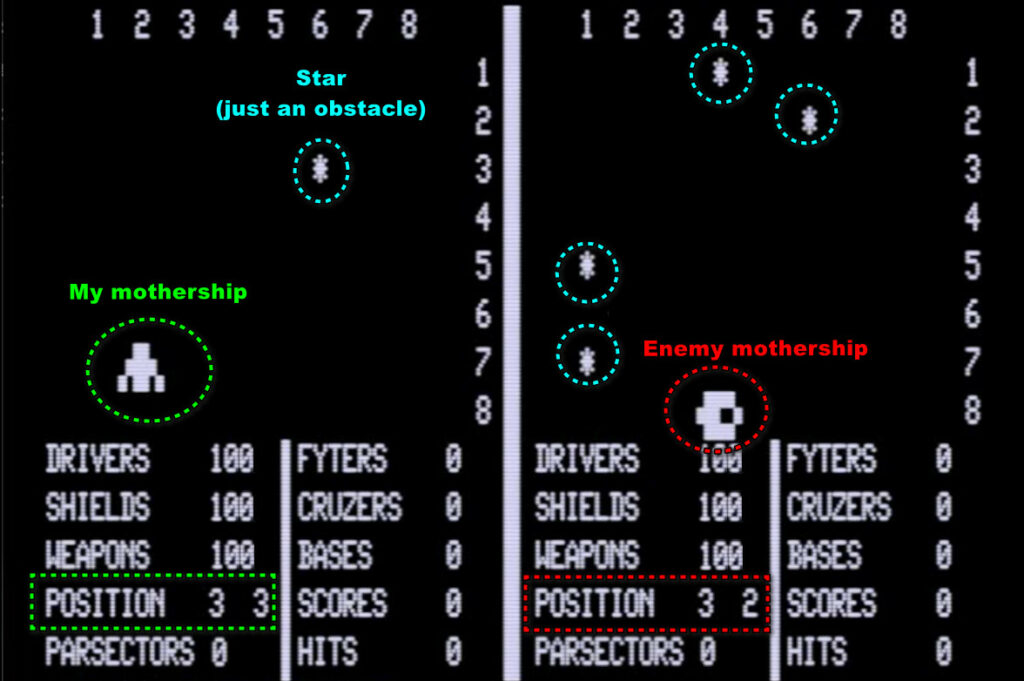
“Position” is compared to the grid below
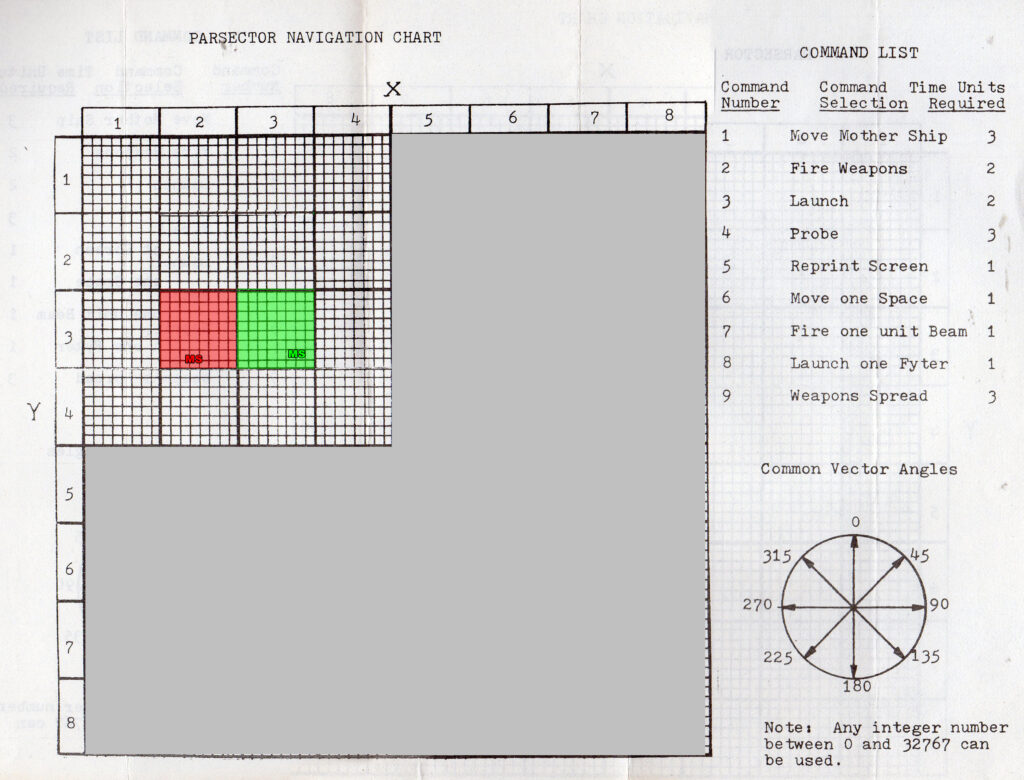
My objective is to control more than two-thirds of the parsectors, so 11 of them. Some lawyery-types will claim that I can also win by destroying the enemy mothership, but that’s purely theoretical and for reasons I will later explain it is pretty much impossible.
To control parsectors, I need to have either a starbase or, missing that, a stronger military presence than my opponent. Initially, of course, I only have my mothership, but motherships can launch smaller ships and bases every turn for free – it only costs time.
The enemy mothership acts first : it launches two pairs of cruisers cruzers, and drops a base in the parsector South of its initial position. The cruzers then move on their own.
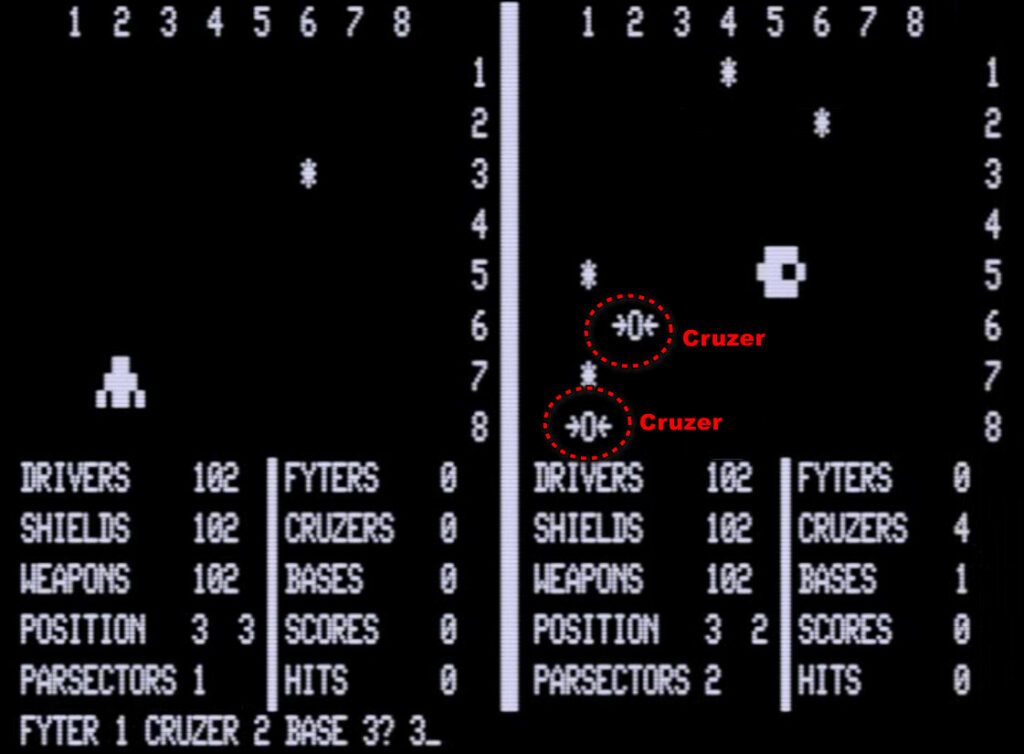
In my strategy, I need to take into account the fact that the AI outproduces me. For 3 time-units (I have 11 every turn), I can launch either 3 fighters fyters or 1 cruzer or 1 base. Meanwhile, for the same cost the AI can launch the same number of fyters but 2 cruzers. Cruzers are more powerful and more mobile than fyters, but if I personally destroy some of the hostile cruzers and bases, I have a chance.
From my initial location, I drop a base, and then another by mistake, then I launch fyters all around across parsectors to the left (where my enemy is), bottom-left (where the enemy starbase is) and bottom.
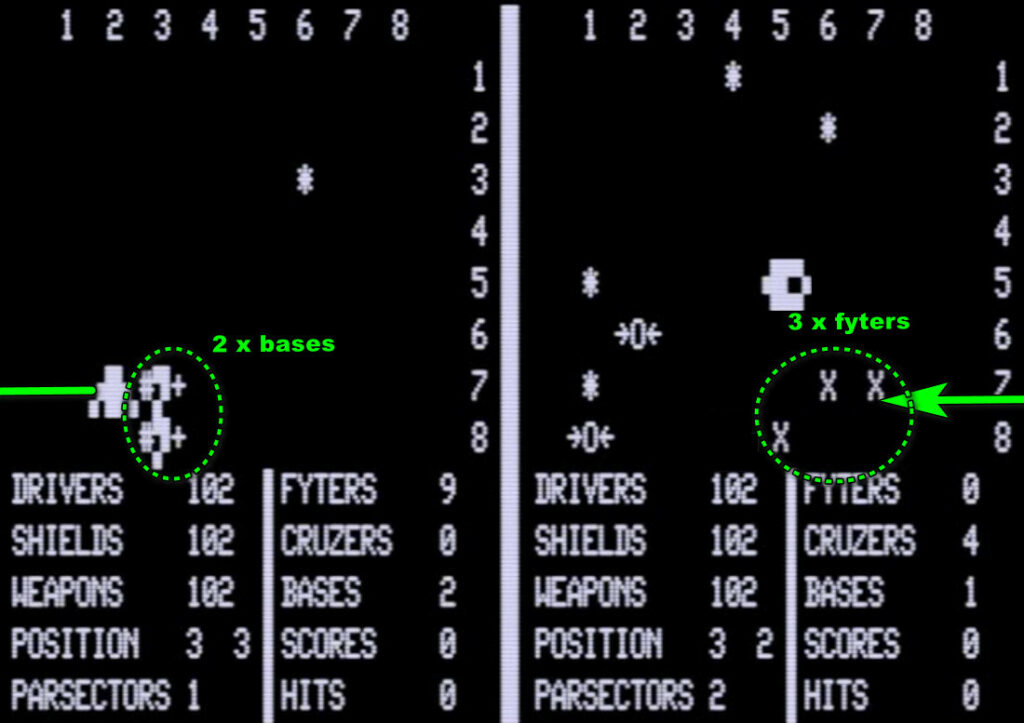
My fyters then live their own lives, and they destroy an enemy cruzer at the cost of two of them. Not really a great trade, especially since my opponent holds its position and launches 4 more cruzers and 10 fyters. The enemy cruzers having travelled a bit and taken more parsectors, the game informs me that my enemy now controls 4 parsectors, while I control only 2.
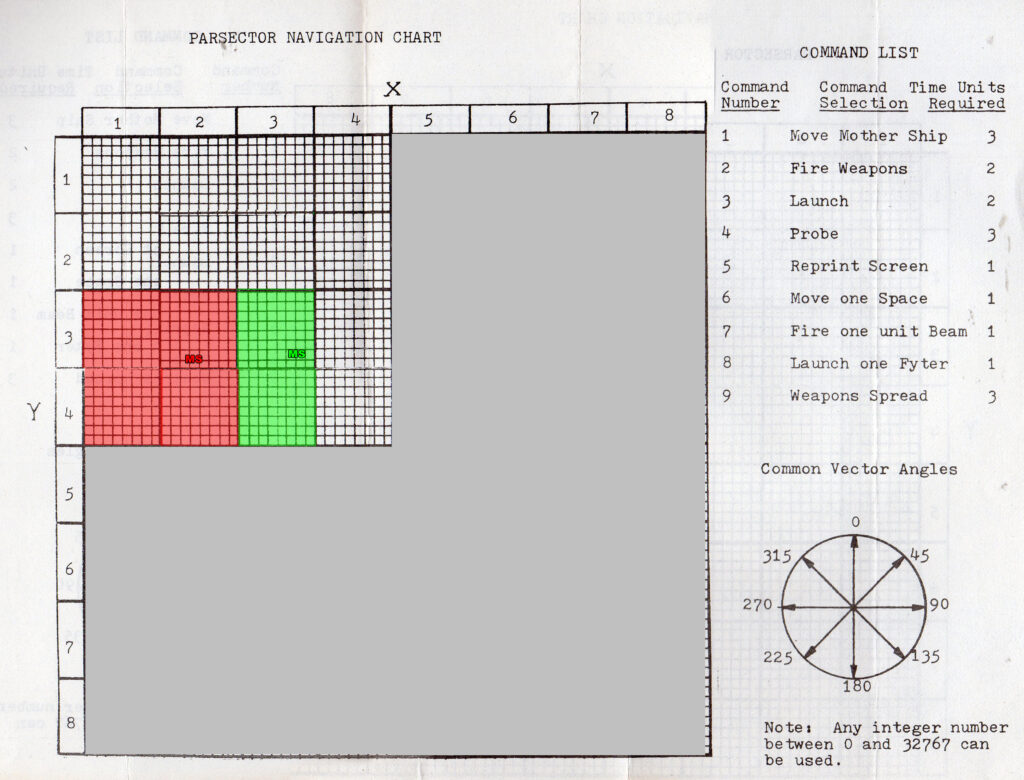
Well, time to be decisive. I jump in the parsector below the enemy mothership, and find a huge enemy armada :
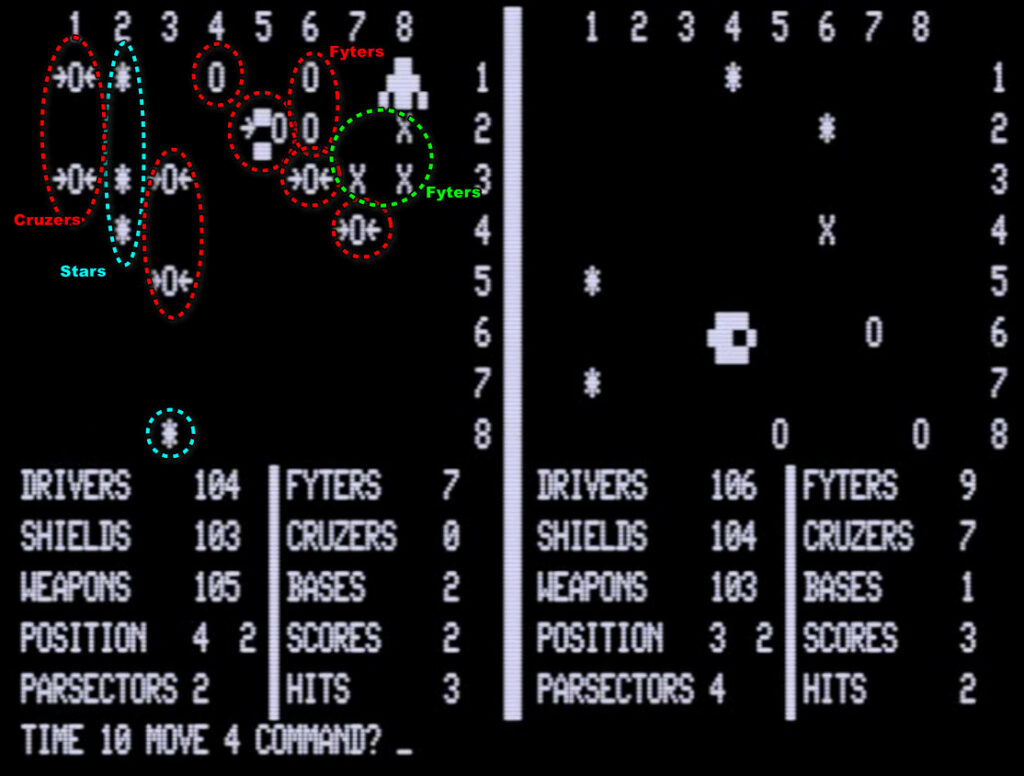
There are 6 of the 7 enemy cruzers, 3 of their 9 fyters and their only base. Time to personally handle them with my beam weapon. I shoot two salves of 7 shots in an arc, cleaning up most of the hostiles, including the base :

For a cost of 6 time-units, I wiped out 7 time-units worth of units, so it looks more impressive than it was, but destroying the base was important : fyters are harmless against them so the base hard-counters my strategy. Furthermore, bases can only be dropped in parsectors without any hostile force – and these get rarer and rarer as the game advances and ships start to go everywhere. This flurry of destruction also allows me to retake control of the parsector.
My opponent flees toward the top of the galaxy, dropping more starbases behind it. I abandon my current parsector to pursue my opponent, destroy one of the new starbases and launch a large number of fyters, as most of mine had been destroyed in automatic fyter-to-fyter combat.
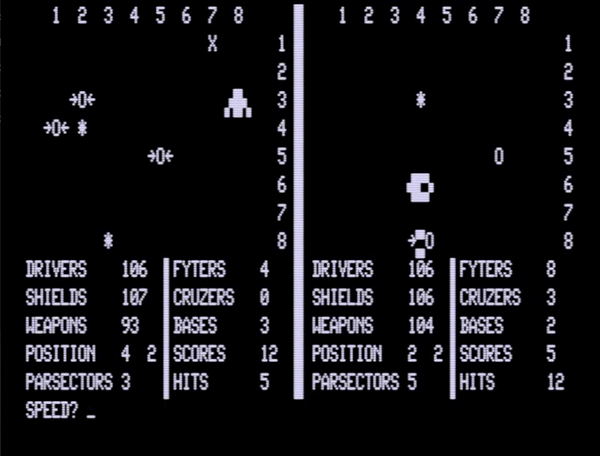
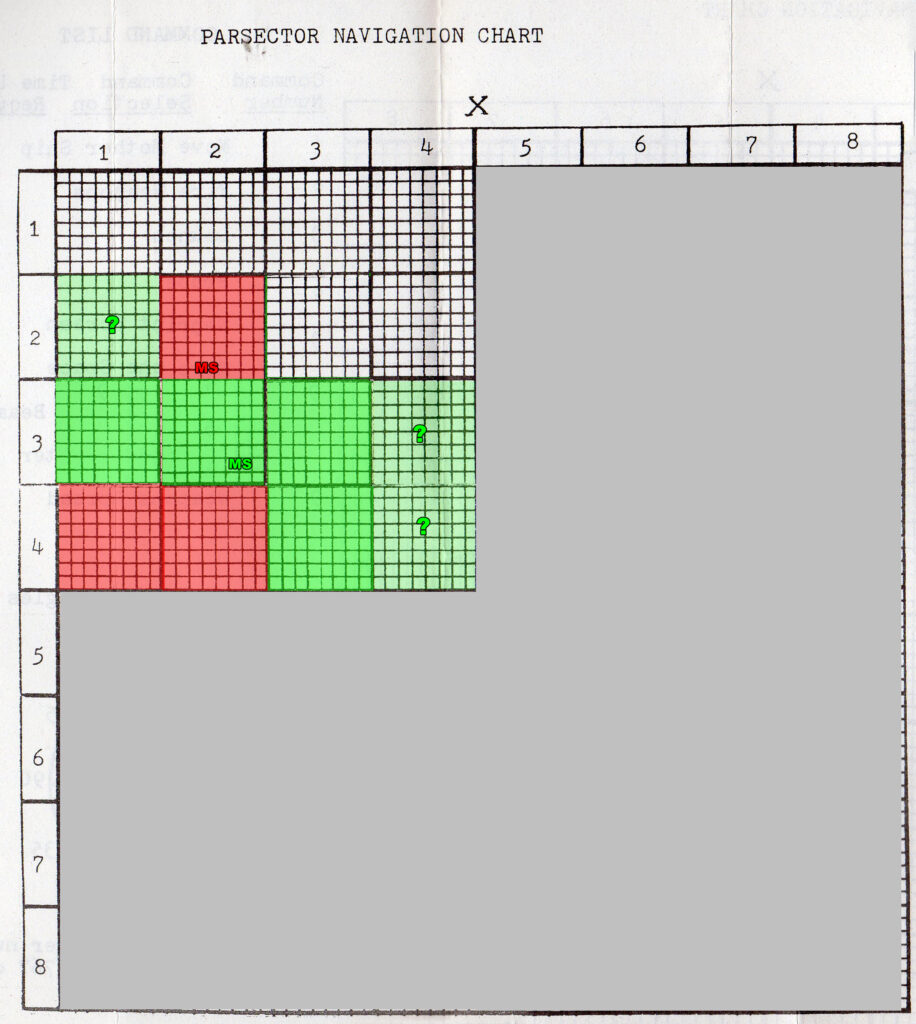
The campaign continues this way, my opponent launches ships and rarely bases, I follow, destroy the starbase, launch my own fyters and then destroy enough fyters and cruzers so that my spacecrafts can prevail locally. Sometimes, if a parsector is clear, I even drop a starbase.
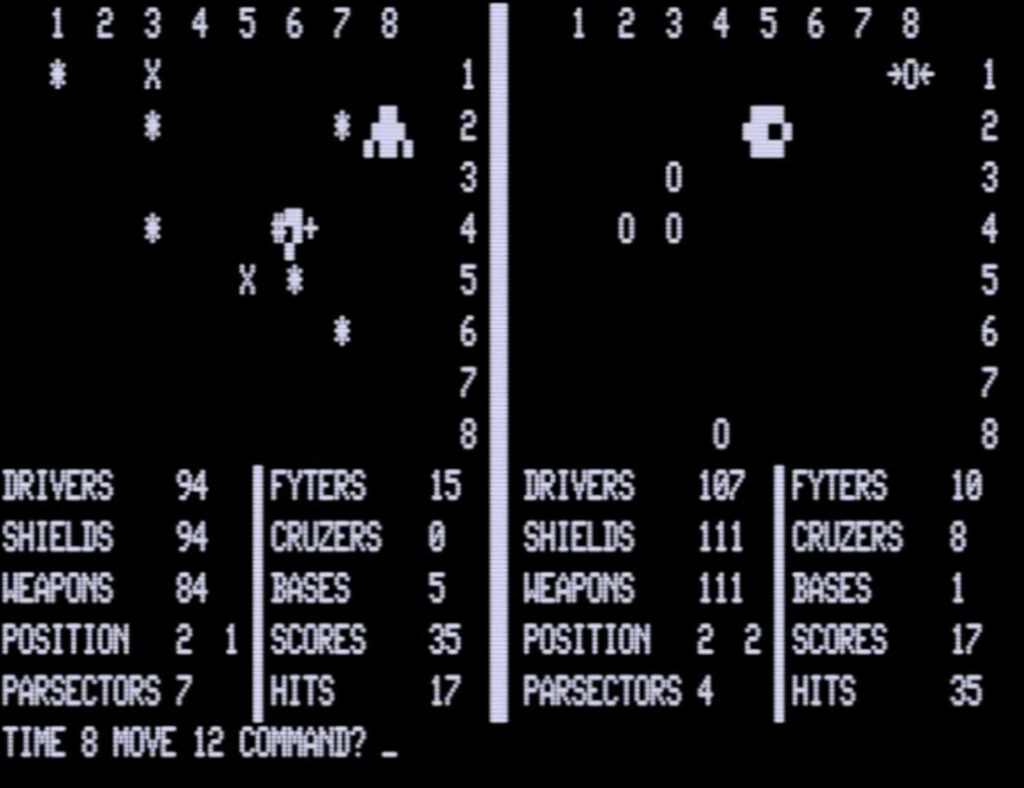
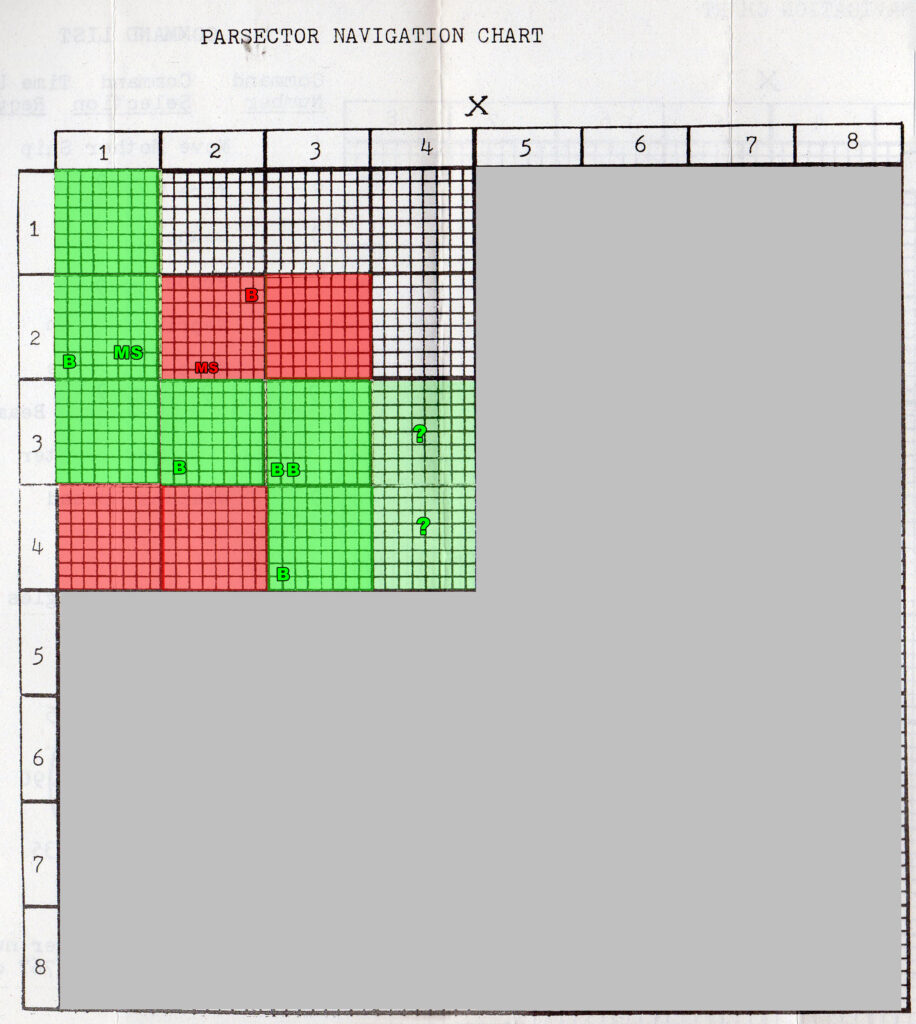
At this point, I am close to the 9 parsectors controlled. When you control more than half of the parsectors, you can launch 4 fyters instead of 3, or 2 cruzers instead of 1 – a decisive advantage. I stop going after the enemy starbases and focus on the “neutral” parsectors.
Meanwhile, the enemy mothership moves to the bottom of the map, still ignoring my bases, so I easily reach that 9 parsector threshold !
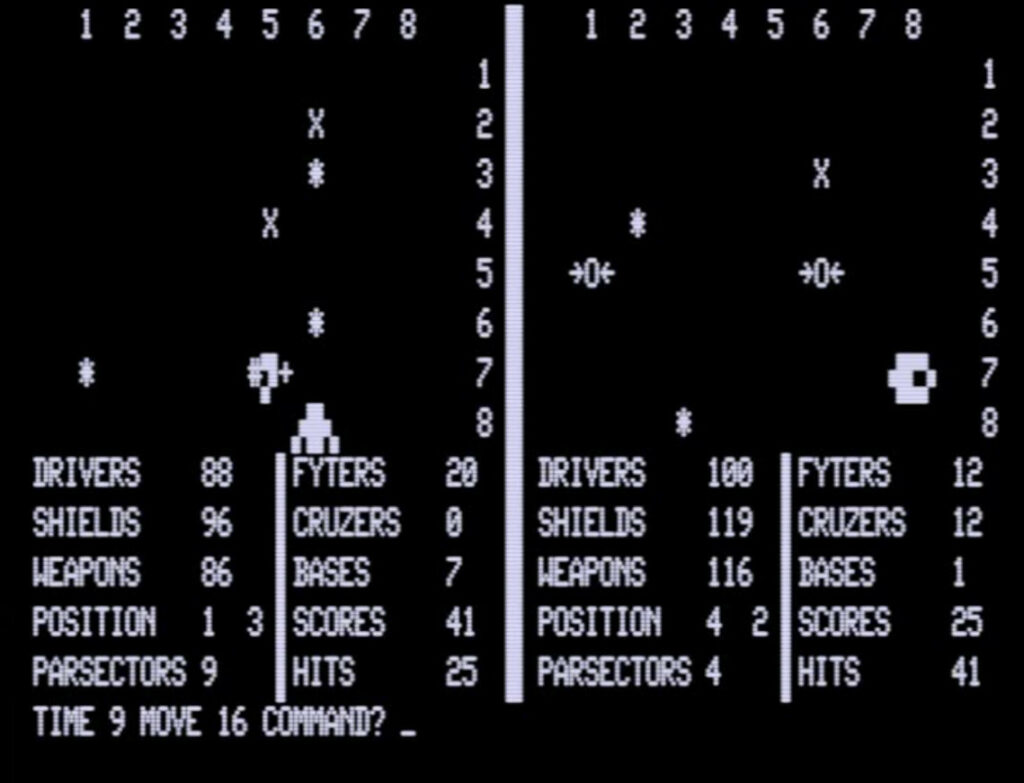
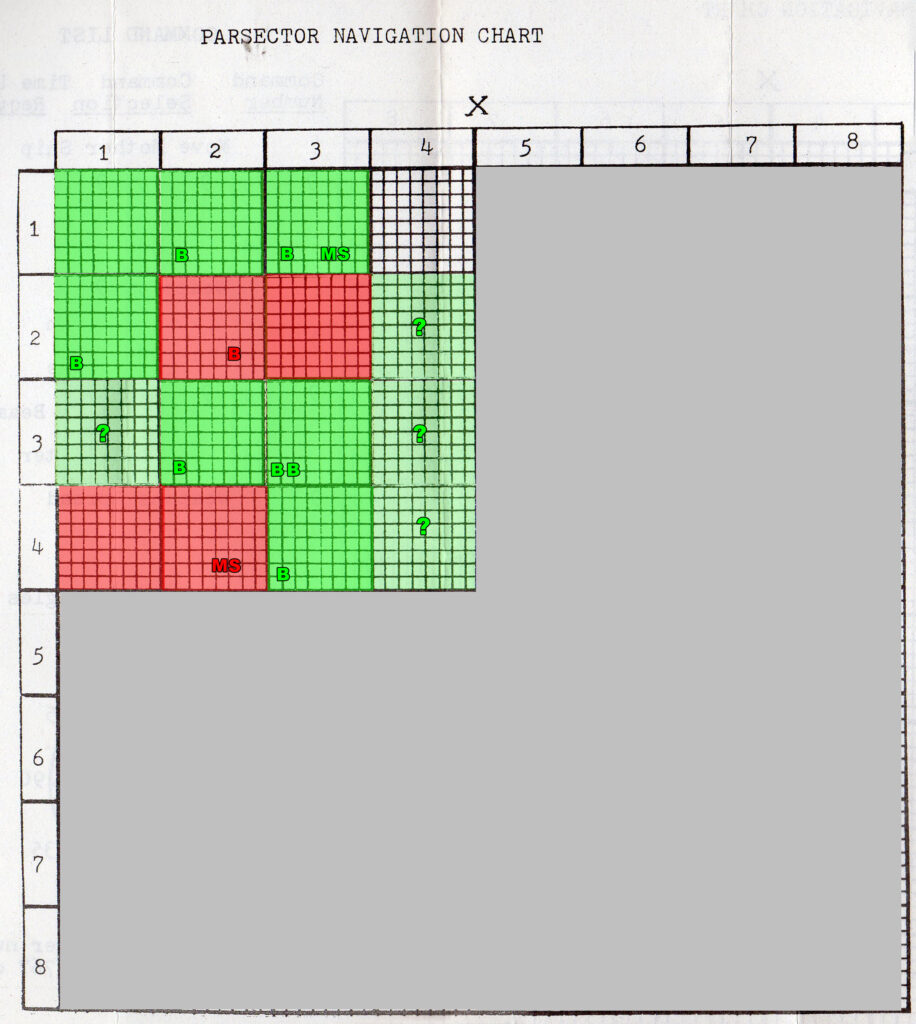
I move to an enemy parsector below my mothership (+1 controlled parsector by virtue of being personally there without enemy bases around), then launch pairs of cruzers all around me. The cruzers cross my parsector’s boundaries during their move, presumably conquering more parsectors – that’s a victory !
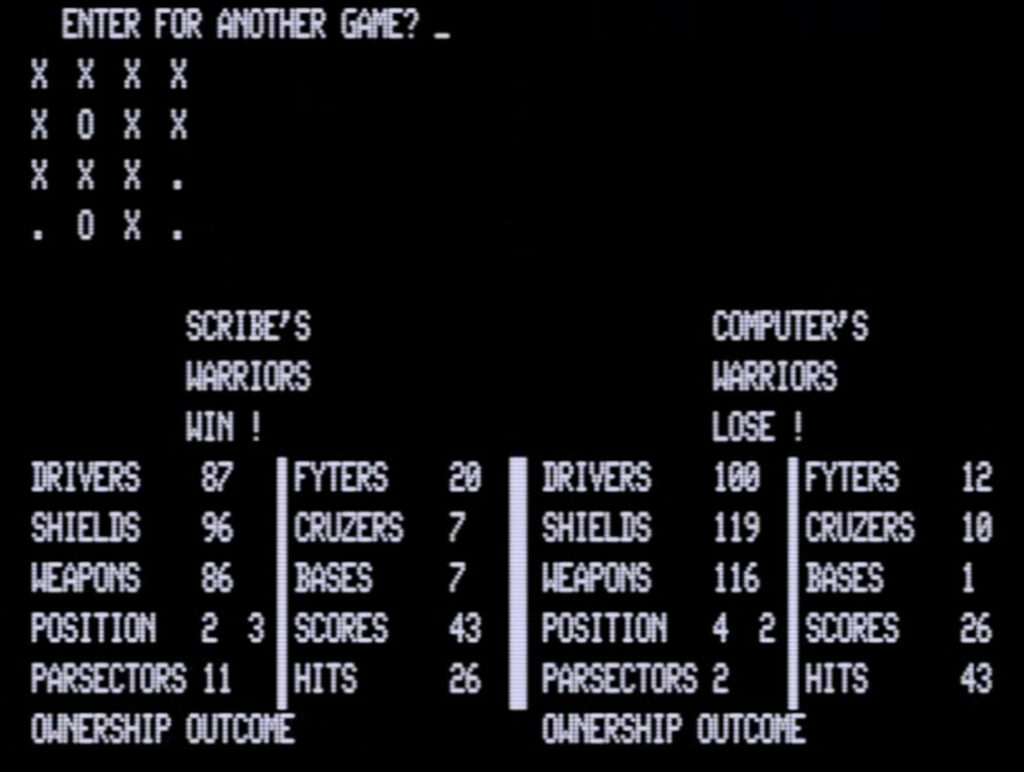
Rating & Review
Parsector V by Brian Rotolante, published by Synergistic Solar, USA
First release : 1980
Tested on : TRS-80 emulator (TRS-80GP)
Total time tested : 4 hours
Average duration of a campaign: 30 minutes for a 4×4 map
Complexity: Easy (1/5)
Would recommend to a modern player : No
Would recommend to a designer : Yes
Final Rating: Obsolete
Ranking at the time of review : 26/63
Unfortunately, there is very little I can say about Parsector V‘s background. Synergistic Solar and Brian Rotolante are not new to this blog, as I already played the creative, though not great, Ants!!! and Space Ace 21, but I had initially skipped Parsector V as I couldn’t find its manual. Recently, Mobygames supercontributor Hoeksmas found several Synergistic Solar manuals and sent them to me, though unfortunately the ones for Hypergate Patrol / Hypergate Centurion are still missing.
What I can say is that Parsector V is a TRS-80 exclusive – just like every other Synergistic Solar game – and was sold in a bundle with Parsector 8, described as the “tournament version” of Parsector V. The only difference between the two games is that Parsector 8 allows maps as large as 8×8, but in exchange does not have an AI to play against. Both games share the same manual.
A. Immersion
Very limited, though I appreciate the “artist concepts” of the spaceships in the manual :
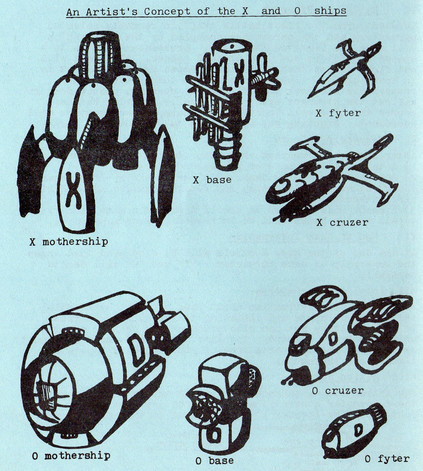
Rating : Very poor
B. UI, Clarity of Rules and Outcome
The game is relatively easy to play and the manual is clear. On the other hand, the game has low tolerance for mistakes, the worst being the game requiring you to waste time-units if you need to display the screen again because you typed a command that does not exist, triggering the game to display error lines. No other game does this for a reason.

Rating : Average
C. Systems
That’s obviously where the game shines. The player has very few orders available :
- moving, an expensive action at 3 time-units, but the movement can go as far as the player wishes (provided they do not meet a star on the way)
- dropping ships at the cost of 2 time-units :
- 1 static base, which can only be dropped in parsectors devoid of ships, but once launched “lock” the parsector for its owner until destroyed
- 1 cruzer, a fast ship (4 tiles/turn) that has a tiny chance of destroying enemy bases,
- 3 fyters, slow ships (2 tiles/turn) that are powerless against bases in my experience but can usually overwhelm the more powerful cruzers,
- shooting up to 7 “weak” projectiles in a beam (angle) around the ship for 3 time-units. I put quotation markers around “weak” because in my experience at short and mid-range they will one-shot any cruzer, base or even star,
- check the content of a specific parsector for 3 time-units,
- minor actions for 1 time-unit :
- Move by 1 tile,
- Launch 1 fyter,
- Shoot one “weak” projectile in any direction,
- Finally, the player can shoot a powerful projectile in any direction for 2 time-units – but I find this almost useless as the weak projectile usually achieves the same result,
That’s all, but those few orders combined with a well-thought ruleset create a deep gameplay.
At the beginning, the players must carefully balance their actions between personally dropping starbases in empty sectors and sending a bazillion starships to do the conquering on their own. The existence of a production bonus for the player controlling 50% of the parsectors means a slow turtling strategy is risky, but the starships only give feeble control on parsectors. Moreover, the fyters are very slow (2 tiles by turn), and the faster cruzers (4 tiles by turn) are typically overwhelmed by the fyters so the player cannot just stay put and send ship after ship either.
If the game does not end early as it did in my AAR, the galaxy fills-in and more decisions must be taken : should the player try to find and occupy the weak parsectors ? Try to just produce so many ships that they conquer the universe ? Personally try to search & destroy the enemy starbases ? Well, a bit of everything, but focusing on one task is a recipe for disaster.
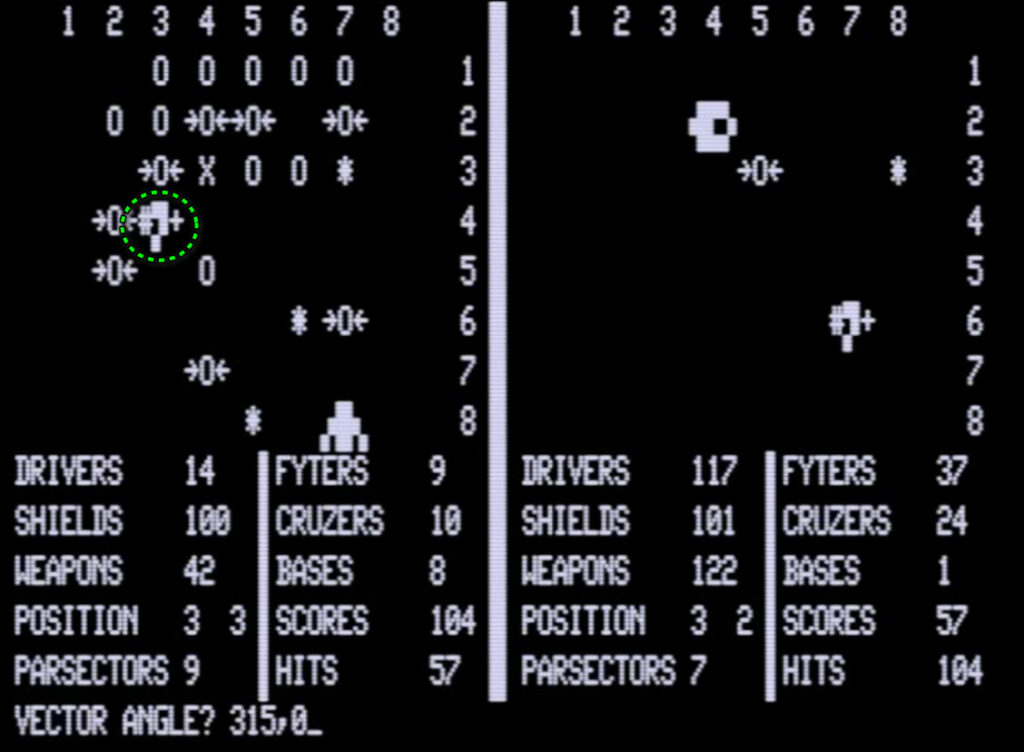
Another layer of complexity comes from the mothership driver/shield/weapon. Drivers are consumed when the mothership is moving, shields when the mothership is hit or collides with other ships (or stars), and weapons obviously are consumed when the mothership shoots. As you can see, launching ships or bases is free of charge.
In most of my sessions, the game ended long before Drivers or Weapons became an issue. But if the game draws out, you will have to be even pickier with your movements or your attacks as each of these values only regenerates by 2 every turn.
Unfortunately, shields are poorly balanced and in my experience whatever you do they will remain high ; even a direct attack from the other ships will only drain 30 shield for every 20 consumed in weapons (the maximum in one attack). Should you bring the shield of your enemy to a negative value, well, you still would not have a decisive advantage as the game will automatically transfer some power from weapons and drivers, so soon enough you will be out of the (important) weapon power while your opponent will be out of (mostly useless) shield power. Shooting at the enemy mothership is a losing strategy. What is a winning strategy though is to selectively shoot at the enemy bases/cruzers/fyters ; of course simply ramming them and counting on your overpowered shield also does the trick.
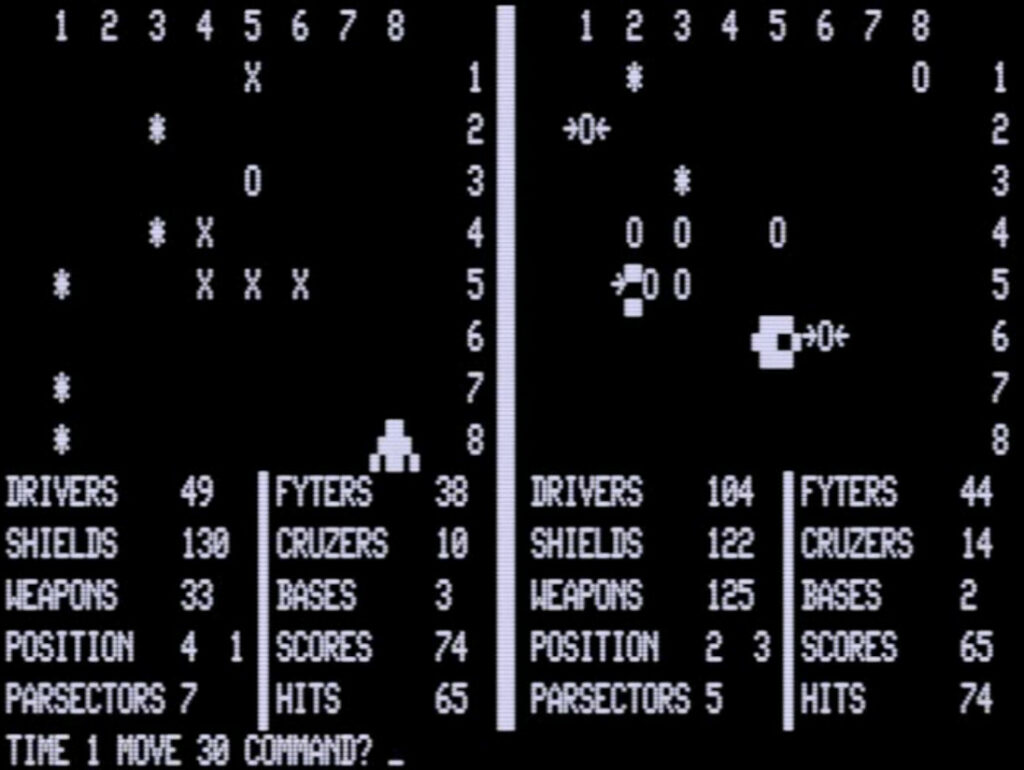
Finally, I should talk about the design decision of not allowing the player to check the status of distant parsectors, except at a prohibitive cost. I initially disliked this choice, but as I played the game I mellowed a bit to it as it adds yet another layer of depth : do you hold the central parsectors and launch ships left and right, or do you explore the world and try to find poorly defended areas. I sometimes found myself organically in situations very similar to Star Trek : jumping into a new parsector to see my base under attack by cruzers, and trying to find the cheapest way (in time-units) to destroy the latter. Still, 3 time-units to check one parsector feels too expensive to ever use.
Rating : Quite good
D. Scenario design and balancing
The game has two customization options :
- Size of the world, between 2×2 and 5×5 (8×8 in the two-player Parsector 8) ; the size of the world determines how many time-units a player has each turn,
- AI bonus, which at medium difficulty is already massive (4 fyters / 2 cruzers by launch)
That’s very few options, and the game feels repetitive. I wished the game included more Star Treky “random encounters” as you visit or revisit parsectors (neutral defensive factions, neutral ships to claim, whatever), it would have added a lot of replayability.
The AI in Parsector 5 is, sadly, pathetic. It wastes its time-units by doing many individual moves rather than a large one, it rams its own ships, it does not actively try to destroy enemy bases or to clean up parsectors to drop its own bases, and generally it has as much long-term vision as a headless chicken. The only reason it had a fighting chance against me was due to its massive bonus and because it cheats by being able to see and thus shoot your ships across parsector boundaries. .
Rating : Very poor
E. Did I make interesting decisions ?
Yes, almost every turn.
F. Final Rating
Obsolete : Parsector 5 has a really strong design, with a lot of strategic depth despite a simple ruleset and short sessions. A decent AI would have added a “well-designed” qualifier, a great AI and a bit more chrome would have pushed the game even higher. A pity, the game system is really unique.
Contemporary reviews
Totally forgotten now, the game received rave reviews when it was launched.
- The serial reviewer J. Mishcon writing for the Space Gamer in April 1981 praised the game, concluding that “it is worth a try for all those who enjoy complex games with the fog of war.
- Much later, a reviewer called Marvin Lewis gave the game a 10 in Softside Magazine (February 1982) “this is indeed an excellent value.” Granted, Lewis never wrote another review for Softside or any other magazine before or after this article, so I am not sure how legit’ he is.
- Finally, W.D. Ives reviewed all the Synergistic Solar games together in 80 Microcomputing Magazine (April 1982) and called it the best game of the lot. The reviewer particularly praised the “secrecy”, which apparently makes Parsector V “such a good game”.
I am surprised by how much the fog-of-war was appreciated – it was initially my main turn-off . I suppose that in 1980 fog-of-war was seen as cool and innovative, as it was nigh impossible to have on a tabletop game. In any case, the game cannot have been popular, given how hard it was to find a manual of it, and since it is not even found on all TRS-80 databases nowadays.
Two pieces of news :
- Hoeksma also sent me the manual for the game I called “Ants!!!” and turns out was actually called “!!!Ants!!!” according to the manual. It included a lot of new information I had not understood ; I put a short addendum at the end of my Ants!!! review.
- Unfortunately, I have to skip Fighter Command for the time being. It uses counters, for which my 2 year-old daughter developed a keen and sustained interest. In one of her offensives, the tactical deployment got scrambled and I deplored at least one counter MIA before the attacker could be lured away with the use of decoys. The rest of the counters quickly retreated to the game box to regroup while waiting for a change of operational situation 🙂 At least I learned that my daughter possibly shares my passion. I should be back to Fighter Command eventually and for now I am instead playing other 1983 SSI games : Knights of the Desert and North Atlantic ’86, which should come soonish.
4 Comments
I suppose that in 1980 fog-of-war was seen as cool and innovative, as it was nigh impossible to have on a tabletop game.
This was how Stellar Conquest, the granddaddy of all space conquest games, was “supposed” to be played. It required five copies of the game, one for each player and one for the referee. Each player would only see what was in sight of his ships. What a gigantic, error-prone pain. Just play on the same board and who cares who can see whom? The game already has hidden spreadsheets where the players track their production.
Computer games were far more suited to such an effort. I’m also pleased to see the term being used correctly. “Fog of war” means the shroud in Starcraft to most gamers today, and telling them that it had an existence before that is an insult to Blizzard.
The grandaddy of tabletop wargaming (Kriegsspiel) considered Fog of War an essential part of the game, even more than dice throws, so the concept is centuries older than Blizzard.
Thankfully.
It’s also difficult to properly implement in real life if not in roundabout ways: I personally never managed to play a proper TT game with it. Only dreams!
Also, it’s heartwarming to see that the Great Destroyers of tokens and miniatures, toddles and pets, have again struck the unprepared.
This was what this blog lacked. Chet has Irene, Jimmy has Dorte.
The Scribe has… Le Petit Scribe!
That would be La Petite Scribe, and even Les Petites Scribes, but I definitely smiled at this.